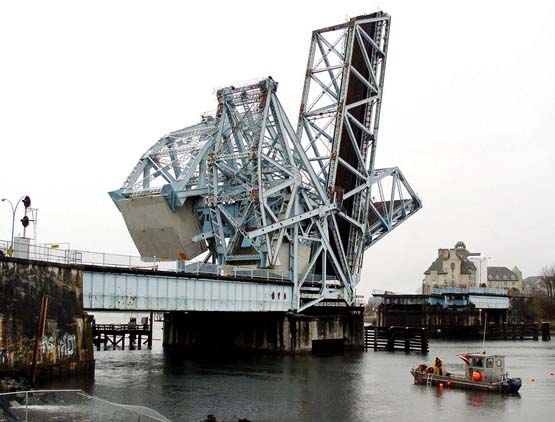
of the Johnson Street Bridge
Victoria Vancouver Island British Columbia - The day has finally come.
After years of controversy, public scrutiny, and more than a few heated Facebook comment sections, the Johnson Street Bridge will be usurped by it's shinier,
more aesthetically pleasing version on Saturday, 31 Mar 2018.
The current "Blue Bridge" will then be taken out of commission, vacating its spot as a neighbour to downtown businesses and as a friend to Wharf
street for nearly a century.
What may not be common knowledge is the Blue Bridge is actually the third bridge to cross the Gorge Waterway at that location, succeeding the Victoria Bridge
and E&N Railway bridge.
Here are a few fun facts about its past iterations and its current existence:
1 - The bridge's first iteration was for wagons back in 1855.
Little is known about the Gorge Waterway's first crossing, The Victoria Bridge.
Originally completed in 1855, the bridge quickly came under scrutiny for blocking boat access to the Inner Harbour.
Thus, the bridge had a short lifespan, occupying The Gorge Waterway from 1855 to 1862.
2 - They replaced the original Victoria Bridge with a ferry service.
We all have our opinions about BC Ferries.
What if the current Johnson Street Bridge was removed in favour of a ferry service?
In 1862, that's precisely what happened.
The Victoria Bridge was removed in order to free up the Gorge Waterway for boats, and a ferry service was its replacement.
3 - The 2nd bridge to cross the Gorge Waterway was a swing bridge.
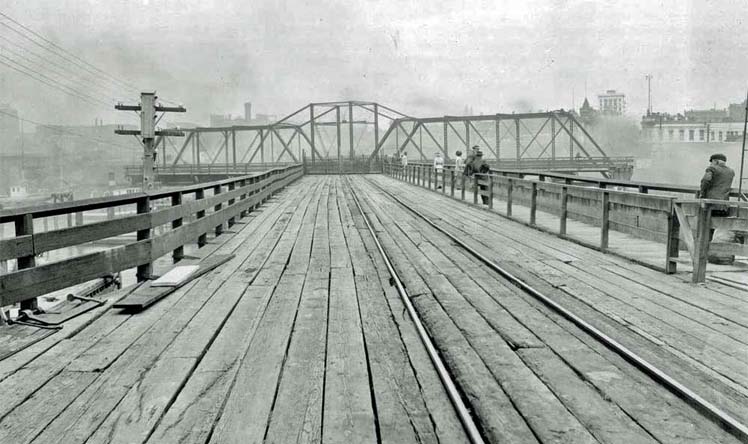
Esquimalt & Nanaimo Railway (E&N) built Victoria its first long term bridge, implementing a swing bridge in 1888.
4 - A former prime minister laboured on the E&N Bridge.
Well.. he hammered the last and final spike of the E&N Railway bridge, not exactly back-breaking work.
Sir John A. MacDonald made his way to Canada's west coast, as the bridge's construction signified the official completion of the transcontinental railway,
which was part of British Columbia's agreement to join Confederation.
5 - Pedestrians had to walk alongside train tracks.
The swing bridge connected Esquimalt to Victoria for 35 years, but eventually, some flaws surfaced.
Mainly, pedestrians had to walk alongside train tracks, while cars and trucks could not use the bridge, just people and trains.
Thus, E&N's design was going to date itself quickly, and it did.
The E&N Railway Bridge had a 35 year life span from 1888-1923.
6 - The man who designed the Golden Gate Bridge also designed the Johnson Street Bridge.
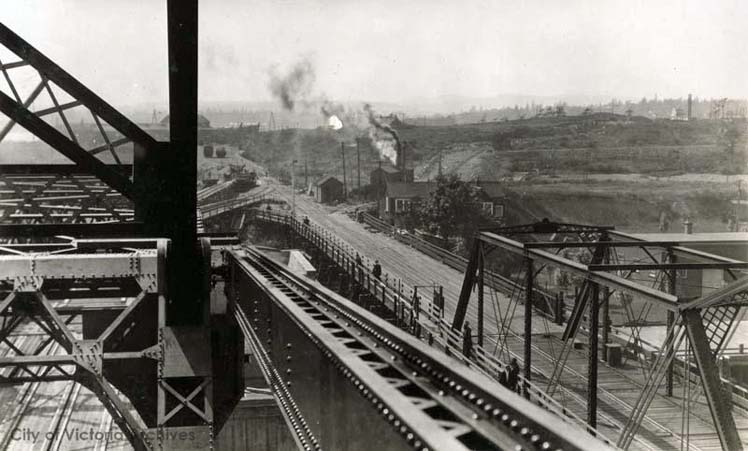
Street rail bridge - Date/Photographer unknown - Victoria City Archives.
Once it was determined that E&N's design wasn't going to work long-term, the city of Victoria began its search for engineers to design its new
bridge.
Joseph Strauss was a leading bridge designer at the time and revolutionized the Bascule Bridge, which are bridges that have a moving span (often referred to as
drawbridges).
It was determined he was the man for the job.
Other than the Johnson Street Bridge, Strauss would go on to design a number of bridges, most notably the Golden Gate Bridge in San Francisco.
7 - The Johnson Street Bridge cost less than a million dollars.
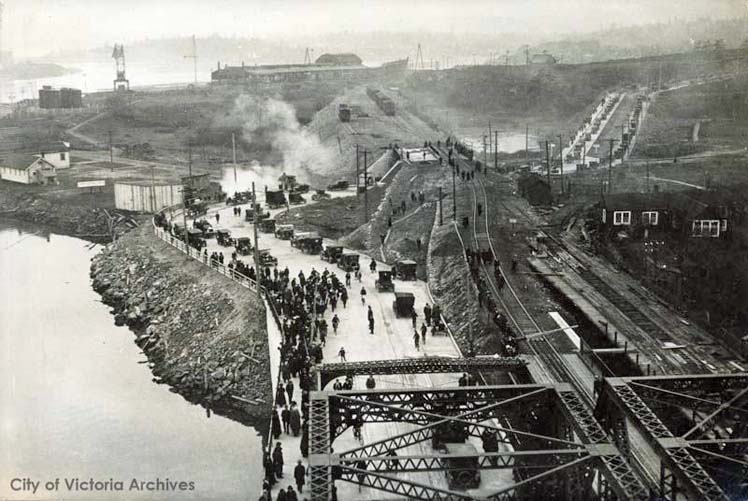
of the swing bridge is still in place - Date/Photographer unknown - Victoria City Archives.
Yes, you read that right.
The 1924 edition of the Johnson Street bridge came in at $918,000.
According to the Bank of Canada's inflation calculator, that's $13.2 million in 2018 Canadian dollars.
8 - Bridges like being over budget.
Despite the original completion price of $918,000, which seems minuscule in today's dollars, the 1924 Johnson Bridge did indeed come in 27 percent over
budget.
As you've heard, the current bridge will cost $105 million, 67 percent more than its original $63 million estimation.
9 - Third time's the charm.
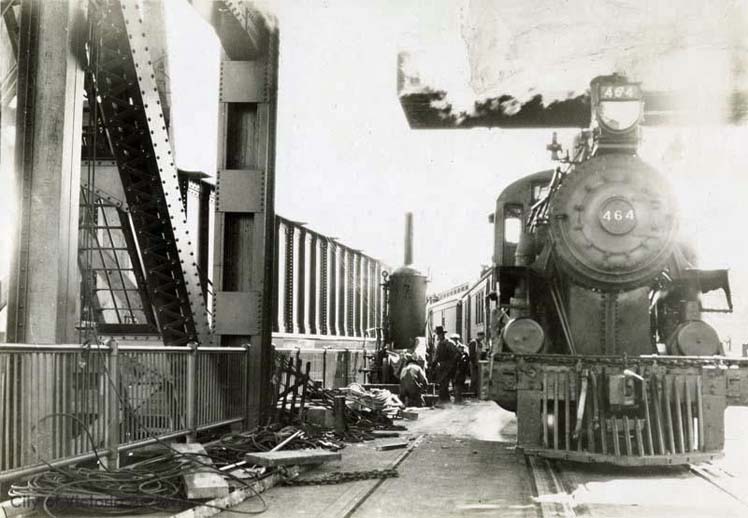
Date/Photographer unknown - Victoria City Archives.
As soon as Victoria's population began to spike in the 1800s, the Gorge waterway was begging for a permanent structure to bridge the gap.
With the Victoria Bridge lasting just 7 years and the E&N bridge sticking around for 35 years, it took the City of Victoria three tries to find a permanent
design that would age well alongside technological advancements.
10 - The original opening was kind of a big deal.
You may have heard that Victoria Buzz will live stream the new Johnson Street Bridge's official opening.
Well, if we could rent a steam pumper for the occasion, we would.
Back in 1924, the Victoria Fire Department brought out a steam pumper to spice up the bridge's official opening, which thousands attended.
11 - 10,000 cubic yards of concrete were used.
10,000 cubic yards or 7.6 million litres of concrete were used for the construction of the sub-structure.
That's enough room for 54 double-decker buses to fit inside.
12 - For fifty-five years the Blue Bridge was actually black.
Turns out the "Blue Bridge" wasn't always as colourful as it is now.
13 - Lamp paint? Why not bridge paint.
Following a multitude of repairs to the bridge in 1979, mostly concerning eroded portions of the superstructure, a new paint job was in order.
The City of Victoria elected to use the same blue paint of the lamp posts since the oxides matched its pigment, and thus, the Blue Bridge was
born.
What if the lampposts had been pink?
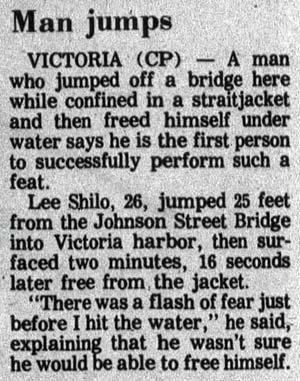 14 - The Blue Bridge has an odd place in
history.
14 - The Blue Bridge has an odd place in
history.
A 26-year-old man stuck in a straitjacket jumped off the Johnson Street Bridge and freed himself underwater.
By his own accord, it was the first accomplishment of the bizarre feat.
Whatever floats your boat.
15 - Steel is lighter than wood.
It seems counter-intuitive that replacing a deck with steel rather than wood would make a bridge lighter.
But in 1966, it was determined that the wooden deck was absorbing too much rainwater, placing a strain on the mechanism.
Thus, the familiar open steel grid decking was born, draining water and lightening the load.
16 - At peak usage 30,000 trips are made across the Bridge each day.
In 2010, it was estimated that the Johnson Street Bridge sees 30,000 trips per day during peak usage.
23,000 (77 percent) were vehicles, 4,000 (13 percent) were pedestrians, and 3,000 (10 percent) were cyclists.
Here's to tens of thousands more on the new bridge, after it finally opens tomorrow (knock on wood).
Jeremy Weeres.
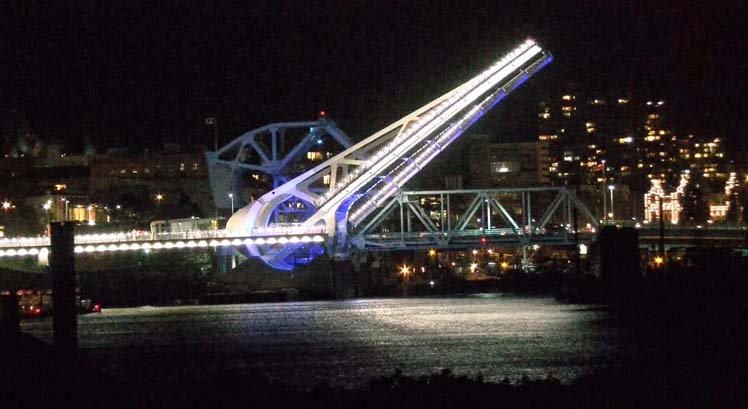
under the provisions in
Section 29 of the Canadian
Copyright Modernization Act.


